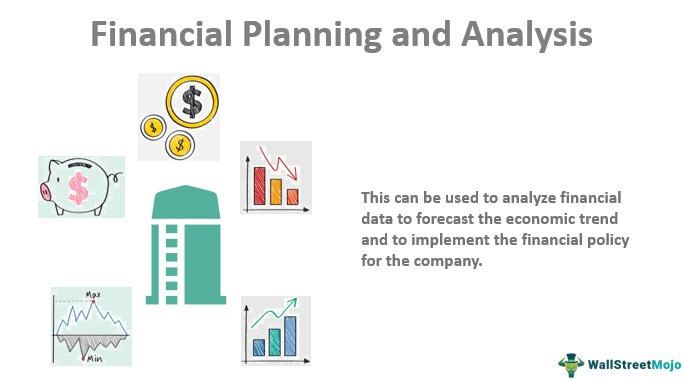Table Of Contents
What Is Financial Planning And Analysis?
Financial planning and analysis (FP&A) is the process of budgeting, analyzing, and forecasting the financial data, which can help the organization to be aligned to its financial goals and also support strategic business decisions of the company; it also helps an investor to know if the company is stable and profitable enough for the investment.

FP&A forms an integral part of any firm's operations; this kind of analysis and forecasting helps the business know the historical trends and anticipate the upcoming trends. This is a pure number-driven process where business analysis also provides some qualitative output for the management; depending on the need and requirement, the company can decide which analysis needs to be considered.
Key Takeaways
- Financial planning and analysis refers to a process that professionals within an organization conduct to assist businesses in planning, forecasting, and budgeting accurately.
- It plays a key role in improving decision-making and helps in achieving organizational goals.
- FP&A can help companies in predicting economic trends and executing financial policies. Moreover, it can assist in developing financial models and setting yearly targets.
- Businesses may use different types of planning methods as part of the FP&A process. Some popular techniques are predictive planning, multi-scenario planning, and driver-based planning.
Financial Planning And Analysis Explained
Financial planning and analysis is the process of budgeting, planning, and executing the financial roadmap to the company’s daily expenditures and overall growth plan. A financial Planning and Analysis director forms an integral part of any organization that can help make futuristic decisions for the company based on the analysis of the data.
Budgeting, Forecasting, Analysis, and Planning are the primary functions of the FP&A, which draws a fair picture for senior management like the CFO or CEO to make any major corporate decision.
Cash flow management and FP&A prove to be pillars for the company's growth, which eventually will generate profits year on year.
Data used to analyze here can be either Quantitative or Qualitative, based on which the analysis can be carried forward to evaluate the company's progress towards the set goals and objectives.
It considers business and economic scenarios and historical trends to anticipate future potential obstacles and, simultaneously, forecast the company's financial results.
If individuals want to develop a comprehensive understanding of key methods and concepts related to FP&A, they can consider enrolling in this Financial Planning & Analysis Course. In the course, an industry expert with vast experience explains several key topics like financial accounting, cost accounting, financial modeling, and financial risk management. The explanations are provided along with examples to help learners build practical knowledge.
Process
Typically, the financial planning and analysis process involves the following steps:
#1 - Accumulation, Consolidation, and Verification of Data
It involves accumulating operational and financial data from data warehouses, enterprise resource planning or ERP systems, and any other business-related solution. Additionally, businesses may collect data externally, for example, broader market, economic, and demographic data. Post-collection, the data must be subject to consolidation, standardization, and verification.
#2 - Planning And Forecasting
The second step involves analysts utilizing the data prepared to create financial estimates that project how the organization will perform and whether it will make progress. Such financial estimates include cash flow forecasts, sales projections, and more. Also, this step involves carrying out financial planning, and for that, popular techniques are as follows:
- Driver-Based Planning: In this case, analysts spot crucial business drivers and create a number of plans. These plans provide a mathematical representation of how different variables can impact those business drivers.
- Predictive Planning: In this case, FP&A professionals utilize large data sets concerning historical performance to create a model. This model helps in projecting future performance.
- Multi-Scenario Planning: More and more businesses are using this planning method. It involves analysts making assumptions regarding the future. They anticipate consequences and create plans for respective scenarios.
#3 - Budgeting
In this step, the professionals project expenses that are necessary to execute their plan. After that, they carry out the allocation of expense budgets for all business units. Some companies opt for zero-based budgeting, which involves steering clear of overspending and bloating via the continuous assessment of expenses to determine which are unnecessary and necessary.
#4 - Performance Tracking And Analysis
The last step of the FP&A process requires FP&A professionals to provide the organization with advice and decision support. For that, they need to conduct the analysis of key financial data, for example, expenses, sales, cash flow, working capital, and other key performance metrics or KPIs. Also, they answer different ad hoc queries and are responsible for translating figures into narratives. Besides these, FP&A professionals have to generate reports, provide data visualizations, and carry out different activities, for example, profitability analysis.
Purposes
Let us understand why large companies dedicate a significant chunk of their time and resources in hiring a financial planning and analysis director by understanding the purpose of the same.
- This can be used to analyze financial data to forecast the economic trend and implement the company's financial policy.
- Since this is done through the financial data, it depicts the financial numbers for the company by analyzing financial statements like cash flow, balance sheet, and income statement.
- There are several purposes for doing financial analysis for any company, like in corporate finance for analyzing the NPV or IRR of any project or in an investment analysis setting where the numbers can be used to analyze the investment.
- The most general way to analyze the data is to do the ratio analysis and compare the same with industry standards or evaluate the historical records.
- A periodic analysis of the financial data will help the entity to maintain the data and analyze the trends to make any managerial decisions for future advancements.
Importance
The financial health of an organization is the prime concentration point for any organization for obvious reasons. The financial planning and analysis software gives them important insights that help them make better decisions in terms of their growth plans or other developmental aspects. Let us understand the importance to completely understand the concept’s intricacies.
- The financial analysis sets a good base for any company to succeed by setting the financial and business plan; adequate planning leads to a better understanding of how the business is performing than the projections.
- In case of financing requirements where the company needs to borrow funds for future advancements, FP&A will try to present a separate finance section in front of the board in a very brief manner. Also, the lender would want to see the numbers before lending out money.
- Accounting and FP&A are two different methods to analyze financial statements; in the place where accounting ends, FP&A takes over. In short, accounting focuses on historical numbers, and FP&A focuses on forecasts and future numbers.
- FP&A strategy links the long-term plans with annual reporting and capital budgeting; with further analysis, it also helps develop financial models and assists in the annual target setting process.
- Consistency and stability are very important in any business. A reliable FP&A process will help get this stability and, at the same time, include reliable information for the management to make sound decisions.
- Most organizations have a dedicated team for FP&A, which continuously tries to improvise and maintain the numbers in the pursuit of many strategic objectives, and finance teams are becoming stronger and stronger by generating effective analysis to create more economic benefits for the organization.
Financial Analysis And Planning vs. Business Analysis And Planning
Some factors differentiate these two ideologies. Both these concepts are often misunderstood for one another. Let us understand the difference in their fundamentals and implications through the comparison below.
- In this, finance-related arrangements are centered around planning and determining inside a financial year, concentrating on meeting the quarterly or YoY target. Other functional teams intend to reduce expenses instead of foreseeing up-and-coming business issues. The analysis is centered around recorded revealing and standard reports joined with worthless models. Reports and data are regularly obsolete and not adjusted to key business drivers. The business analysis approach includes exercises from capacities critical to pushing the business ahead – for example, marketing, sales, and operational management – all lined up with the organization’s key vision. As opposed to focusing on only budgetary or financial valuation, the organization coordinates key useful regions that straightforwardly impact business results.
- While evaluating the financial numbers, reflect the financial picture of any company. However, some executives feel that the reality of new and changing business trends is not included in these numbers. This puts out a whole picture for making any management decision for the company. It is based on available data, and Business analysis helps the management know the vibe in the market about any particular business.
- Some corporates are also of the opinion to change the FP&A to Business planning and analysis due to the wide horizon it covers for analysis; numbers from Financial analysis might help any company make a decision. Still, it might be from a short-term perspective, while business analysis will create a more realistic report based on the ongoing trends in the economy.

